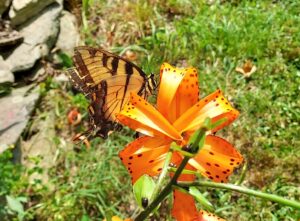Butterfly Season is Here: The Eastern Tiger Swallowtail Butterfly
I think it was my twelfth birthday when I received a butterfly and moth capturing kit. It came with a fine-meshed insect net and other items for euthanizing and mounting specimens in a display frame.
With my net in hand, I ventured forth to hunt my butterfly prey. I caught 3 butterflies, a single moth and, with the help of an older sibling, completed the process of “insect euthanasia.” I mounted the flattened dead butterflies and moth in the frame included with the kit and proudly displayed them on my bedroom wall.
My captured butterfly prey hung there for about a year, but I lost interest in continuing the hobby, and that single frame was the only evidence of my stalking days of youth. Both my grandfathers were avid hunters and kept evidence of their experience with specimens of deer and pheasant. My hunting prowess, however, never developed beyond three butterflies and a single moth.
I was reminded of this last week when we saw four beautiful Eastern Tiger Swallowtail and two Black Swallowtail butterflies circling and feeding on a large patch of tiger lilies at our house. My wife Julie tends these beautiful blooming flowers in a large bed surrounding the ancient sugar maple tree residing in our backyard. Each butterfly was flitting around the lilies and gently alighting on the bright orange blooms to feed on the nectar hidden within. Both species are similar in habits, but with this column I am focusing on the Eastern Tiger Swallowtail and have included a picture I took of one of them.
The Eastern Tiger Swallowtail butterfly is one of our most common butterflies and is found east of the Mississippi River and west into the Great Plains states. They are easy to spot due to their size. When basking in the sun, their wings stretch between 3 and 5.5 inches from tip to tip.

Vibrant yellow, broad wings are edged in black with four tiger stripes tapering from the forewing margin into the yellow wings. The bottom edges of the female hind wings have beautiful bluish scales and an iridescent blue wash over part of the wings with one or more red spots. The male typically has darker black colors but doesn’t have the bluish hind wing and scales like the female. The forked appearance of the hindwings gives this butterfly the swallowtail name. The Eastern Tiger Swallowtail pictured with this column is a female. I hope she is laying eggs nearby.
The Eastern Tiger Swallowtail prefers nectar from a variety of plants including wild cherry and lilac. They seem to enjoy our tiger lilies, but milkweed and Joe-Pye weed are also summer favorites, both of which bloom in our backyard and pasture.
The life span of these Swallowtail butterflies includes up to two broods in their northern range and up to three broods in their southern range. The female lays eggs singly on the leaves of host plants. The final brood in our region overwinters in the chrysalis stage until emerging in the spring.
Tree species preferred by the caterpillars include cherry, magnolia, basswood, tulip tree, ash, cottonwood, willow and birch. We have ash trees in our neighborhood and a medium size black birch tree in our yard, so we’re hopeful for future generations of Eastern Tiger Swallowtail butterflies.
The young caterpillars are brown and white and can resemble bird droppings. When mature they turn bright green with black, yellow and blue false eyespots on the thorax and above their actual eyes. If disturbed and attacked, these false eyespots allow the caterpillar to quickly change from a placid worm to the appearance of a snake head with conspicuous scowling eyes, nose and mouth.
This amazing mimic display puts off predators, such as birds, but that’s not the only way they escape death. They also absorb toxins from the host plants they dine on. If pecked, the caterpillar sends out a foul-smelling acidic secretion that wipes onto the predator animal. These defensive actions and warning display scream “back off,” likely saving many a caterpillar.
Eastern Tiger Swallowtails can be found in eastern North America from Ontario south to the Gulf Coast, west to the Colorado plains and central Texas. Eastern Tiger Swallowtails are in the family of Papilionidae, which has more than 550 species worldwide. Most Papilionidae are tropical, but members of the Papilionidae family inhabit every continent except Antarctica.
Julie and I are delighted to be host and home to butterflies and myriad other beneficial insects. My butterfly catching days are long over. Nowadays I prefer to just observe and appreciate them. If I can snap a photo or two, those pictures are all the trophy I need.
This summer is certainly revealing the season’s potential extremes with weeks of drought conditions and heatwave temps in the 90s. It is, however, still a time when amazing creatures are enjoying our woods and fields here in The Last Green Valley National Heritage Corridor. I encourage you to get outdoors on cooler mornings and evenings to explore and look for butterflies. You never know what you might discover in your own backyard.
We live in a beautiful region called The Last Green Valley National Heritage Corridor. I hope you’ll join me and together let us enjoy it, care for it, and pass it on.
Information for this column was sourced from the US Forest Service, website, and other online sources.
Bill Reid is the Chief Ranger of The Last Green Valley National Heritage Corridor. He can be reached at 860-774-3300 or via email at bill@tlgv.org
Exploring The Last Green Valley, Saturday, August 14, 2022
The Norwich Bulletin is granted first serial rights and associated electronic rights to publish the following article. The Last Green Valley, Inc. retains all other rights to the work.
Get Connected
Sign up for our newsletter
"*" indicates required fields



